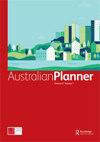Resistance is fertile: exploring tiny house practices in Australia
IF 1.5
Q2 Social Sciences
引用次数: 8
Abstract
ABSTRACT For many Australians, the current crisis in housing affordability and availability has created an impasse in relation to the dream of home ownership. Having begun in America in the 1990s and emerged relatively recently in Australia, the tiny house movement is largely positioned as a direct response to this crisis. Currently, there is little research on the motivations of those in the movement who are living in a tiny house on wheels (or THOW) or other unregulated tiny house options. Based on a qualitative multi-methodological study involving a number of Australian tiny house dwellers, builders and advocates, this paper examines Australian tiny housing trends like the THOW that are outside of current regulations, focusing on how they are lived and experienced among obvious grey areas in current planning, building and housing codes. Taking an interdisciplinary approach, it draws on multiple conceptual perspectives to open out a discussion that moves beyond affordability and availability discourses to argue that such tiny house trends also represent different resistant and spatialising practices within the dominant housing model, creating politically autonomous zones. Offering a novel morphology of informal architecture, I further suggest that these resistant practices invite the development of different planning approaches and practices.抵抗力很强:探索澳大利亚的小房子做法
摘要对许多澳大利亚人来说,当前住房负担能力和可用性的危机已经造成了与拥有住房梦想有关的僵局。小房子运动始于20世纪90年代的美国,最近在澳大利亚兴起,在很大程度上被定位为对这场危机的直接回应。目前,很少有人研究那些住在有轮子的小房子(或THOW)或其他不受监管的小房子里的人的动机。基于一项涉及许多澳大利亚小型住宅居民、建筑商和倡导者的定性多方法研究,本文考察了澳大利亚小型住宅的趋势,如目前法规之外的THOW,重点关注他们在当前规划、建筑和住房法规中明显的灰色地带中的生活和体验。它采用跨学科的方法,从多个概念角度展开了一场超越可负担性和可用性论述的讨论,认为这种小房子趋势也代表了主导住房模式中不同的抵抗和空间化做法,从而创建了政治自治区。提供了一种新的非正式建筑形态,我进一步建议,这些抵制性的实践邀请了不同规划方法和实践的发展。
本文章由计算机程序翻译,如有差异,请以英文原文为准。
求助全文
约1分钟内获得全文
求助全文

 求助内容:
求助内容: 应助结果提醒方式:
应助结果提醒方式:


